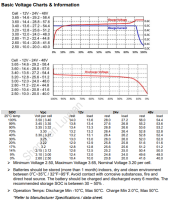What charge settings are optimal for my setup?
I have a 48V 100AH LiFePower4 Battery by EG4 and a JK48V100 100 AH LiFePO4 Jakiper Battery that I plan to run with 2 kW of solar and a MidNite Solar MN3548DIY Inverter/Charger. The Jakiper arrived first and has been operating for a week (replacing flooded lead acids that ran fine for months), and I plan to add the LiFePower4 in parallel shortly.
I read the following thread about float charge for LiFePO4:

 diysolarforum.com
and am asking a similar question to ensure I understand/see if I've missed anything.
diysolarforum.com
and am asking a similar question to ensure I understand/see if I've missed anything.
The LiFePower4's spec sheet reports:
CHARGING VOLTAGE REC. 58 V
REC. BULK VOLTAGE 57 V
REC. FLOAT VOLTAGE 56.5 V
REC. ABSORB VOLTAGE 56.5 V
The Jakiper manual states:
Recommend Charge Voltage: 58.4 V
I've set the inverter/charger to:
Battery Type: L16
Battery Absorption charge voltage: 58.4 V
Battery Absorption charge time: 120 minutes
Battery float charge voltage: 56.4 V
The system runs my fridges and freezers in solar-only charging and inverter priority (failing to the mains if the battery level drop too far). Since there is a constant load on the battery, perhaps I'm going OCD and the float voltage and differences between the batteries' recommended charge voltages doesn't really matter? What would you set the charge voltage to?
Thanks,
Eric
I have a 48V 100AH LiFePower4 Battery by EG4 and a JK48V100 100 AH LiFePO4 Jakiper Battery that I plan to run with 2 kW of solar and a MidNite Solar MN3548DIY Inverter/Charger. The Jakiper arrived first and has been operating for a week (replacing flooded lead acids that ran fine for months), and I plan to add the LiFePower4 in parallel shortly.
I read the following thread about float charge for LiFePO4:

Float LiFePO4 or not??
Can someone give a definitive answer if you should turn off float stage in charge controller for LiFePO4 cells? I see conflicting information in messages here. Most of the information I see says Float should be disabled completely. cc: @Steve_S
The LiFePower4's spec sheet reports:
CHARGING VOLTAGE REC. 58 V
REC. BULK VOLTAGE 57 V
REC. FLOAT VOLTAGE 56.5 V
REC. ABSORB VOLTAGE 56.5 V
The Jakiper manual states:
Recommend Charge Voltage: 58.4 V
I've set the inverter/charger to:
Battery Type: L16
Battery Absorption charge voltage: 58.4 V
Battery Absorption charge time: 120 minutes
Battery float charge voltage: 56.4 V
The system runs my fridges and freezers in solar-only charging and inverter priority (failing to the mains if the battery level drop too far). Since there is a constant load on the battery, perhaps I'm going OCD and the float voltage and differences between the batteries' recommended charge voltages doesn't really matter? What would you set the charge voltage to?
Thanks,
Eric



